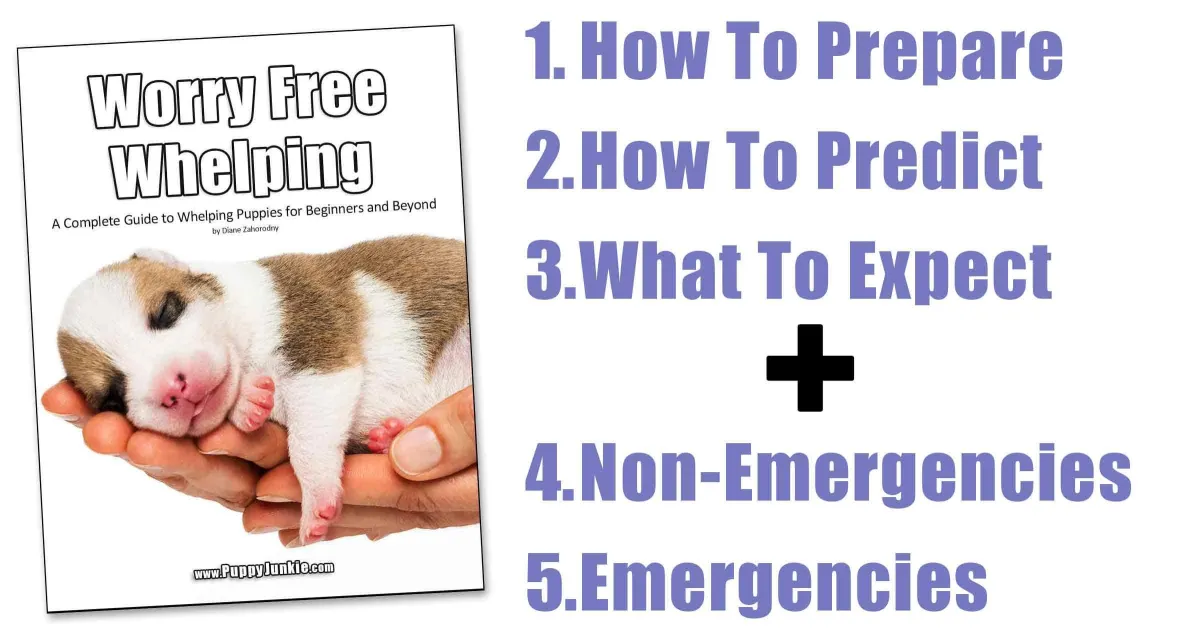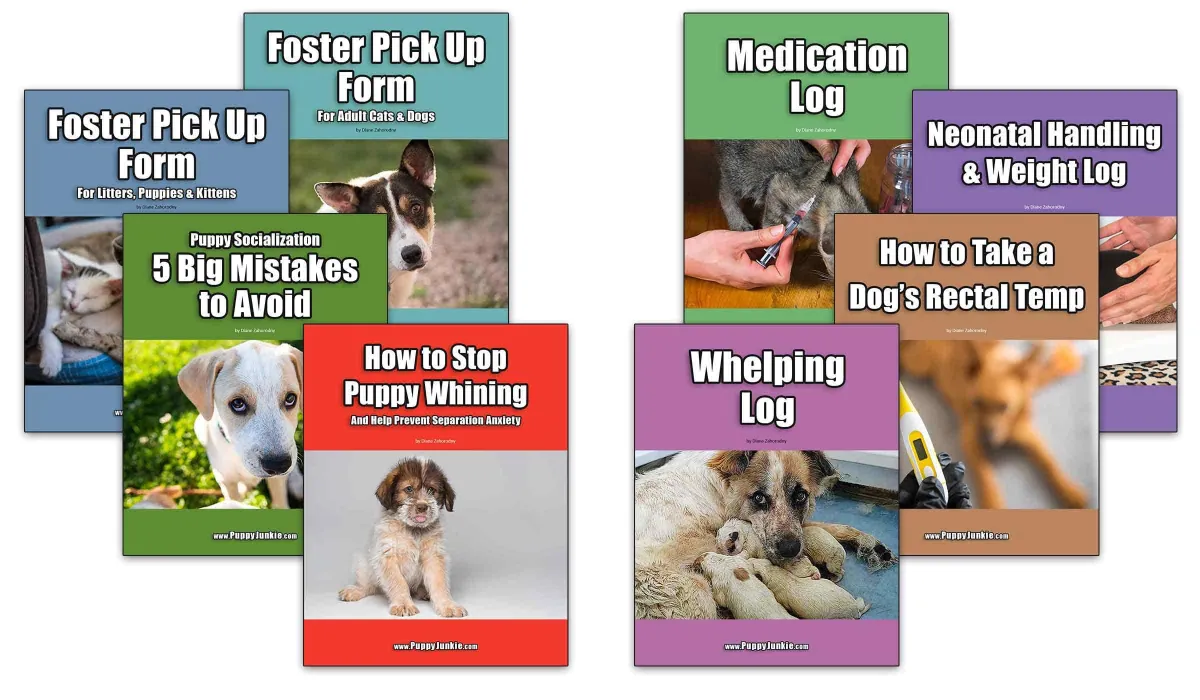
Beginner's Guide To Whelping Puppies
March 22, 2024
by Diane Zahorodny
Witnessing the birth of a litter is exciting, amazing, meaningful, nerve wracking and gross. I highly recommend it. My background is in fostering but this guide is for breeders and pet owners, too.
Whelping, or to whelp, means to give birth and is the term used for dogs. Bitch is the term for a female dog and dam means female parent. In this article, I will use bitch, dam and mom interchangeably.
Here, you will learn about how to prepare for and predict when puppies will arrive as well as what you can expect during whelping. My full Worry Free Whelping Guide can be downloaded for free and it has everything you see here plus how to identify and help deal with problems and whelping, weight, neonatal handling, temperature and medication logs.
Included In This Article
How To Prepare
How To Predict
What To Expect
Included In Full 'Worry Free Whelping Guide'
How To Prepare
How To Predict
What To Expect
When To Intervene: Non-Emergencies
When To Intervene: Emergencies
1. How to Prepare for Whelping
Reasons Not to Worry
If you are nervous about the birth of a litter, just remember that dog mamas have been giving birth without our help for thousands of years! You may not even be there because you’re at work or it’s the middle of the night, and this is OK. Generally speaking, it is best to intervene as little as is necessary. Too much help may interfere with natural maternal processes and, consequently, she may reject her offspring. If mom is alert but not in distress, tending to her puppies who are squirming and noisy and there are no foul odors, it’s safe to leave them alone. Just take a deep breath, stay calm and do the best you can.
Reasons to Worry a Little
On the rare occasion that something does go wrong, it can be quite stressful and upsetting. Sad but true: Sometimes puppies are born dead or die shortly after birth. For whatever reason they fail to thrive and sometimes there is nothing you can do. If the death of a puppy is more than you can handle, you might consider not being present during the birth or that whelping a litter may not be for you.
Whelping Area
You’ll need a whelping box in a quiet, temperature-controlled room with a door to keep mom in and other animals out.
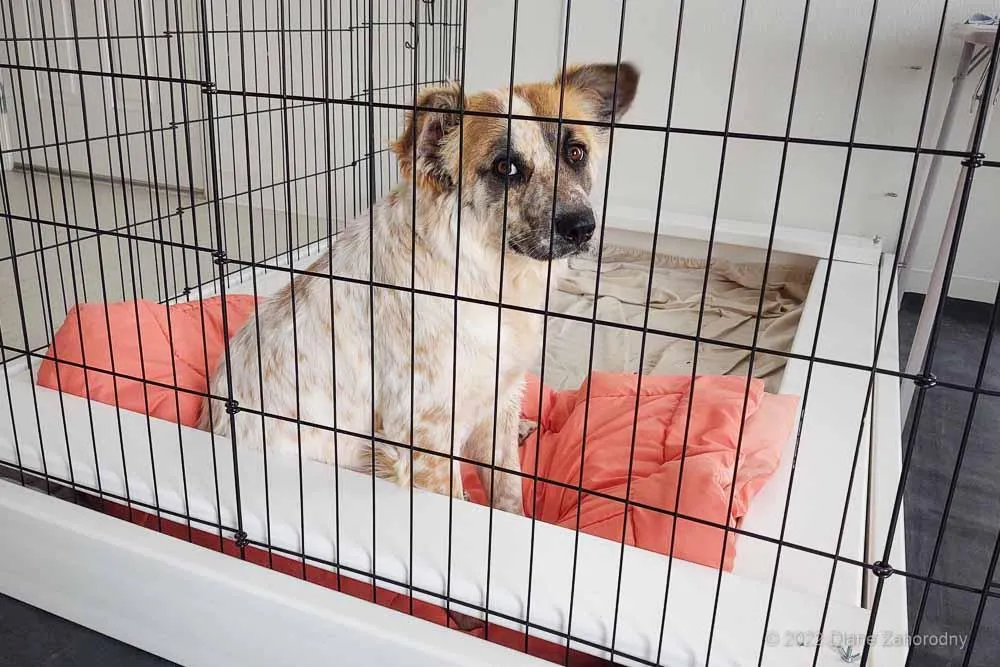
Whelping Box: A space designed for dogs to give birth and raise their puppies until their eyes and ears open around 2-3 weeks old. There’s a wide range of whelping box options from cheap and disposable to stylish and reusable. READ Ultimate Whelping Box Guide
Large enough for mom to fully stretch out, move around and get in and out of easily
Bumper rail (or pig rail) that goes around the inside of pen. This prevents mom from accidentally smushing a puppy against the side
Solid sides to prevent drafts and provide privacy. If using a wire pen, cover the walls with sheets or blankets
Easy to clean and sanitize with a waterproof floor. Whelping is messy and the fluids will permanently stain blankets, carpet, floors, etc. Just before labor begins, remove all bedding (puppies can become lost and smushed in loose materials) and lay down large potty pads or hospital pads. As they become soiled, remove and replace or lay fresh on top
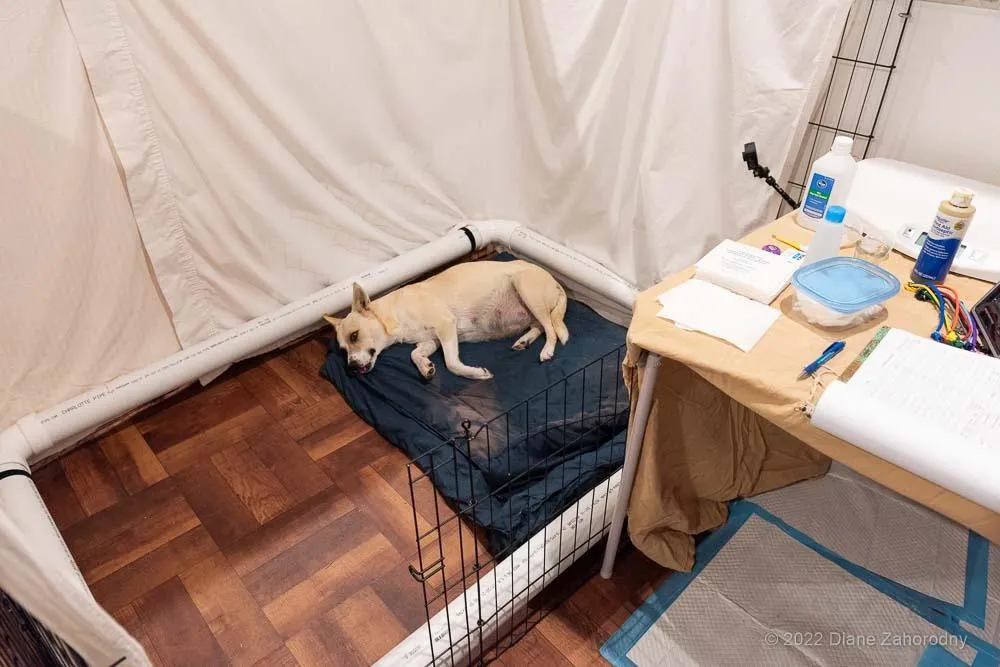
Temperature in the room should be around 75°F/24°C with no drafts. It may be tempting to provide supplemental heat, but do so very carefully. If using a heating pad or heat lamp be sure it is carefully secured in place, there are no accessible wires and that mom and puppies can easily move away from the heat source. Too hot is just as dangerous as too cold
Restrict mom to the whelping area as she may choose a less desirable location to give birth (you don’t want her hiding under your bed or porch)
Do not allow any other animals in the whelping room. Some bitches will tolerate human onlookers. Ask guests to be quiet and still. If mom seems stressed, ask guests to leave
Take Notes
Good notes are invaluable to your veterinarian in case of an emergency. Note the date and time of the following whelping events in my Whelping-Log.pdf (see Free Downloads)
Temperature drops (see free downloads for How To Take a Temp and Temp Log)
Nesting begins
Appetite diminishes
Panting starts
Abdominal straining observed
Appearance of green, black or reddish-brown vaginal fluid
When each puppy first appears in birth canal
When each puppy is fully out of birth canal
Whelping Kit
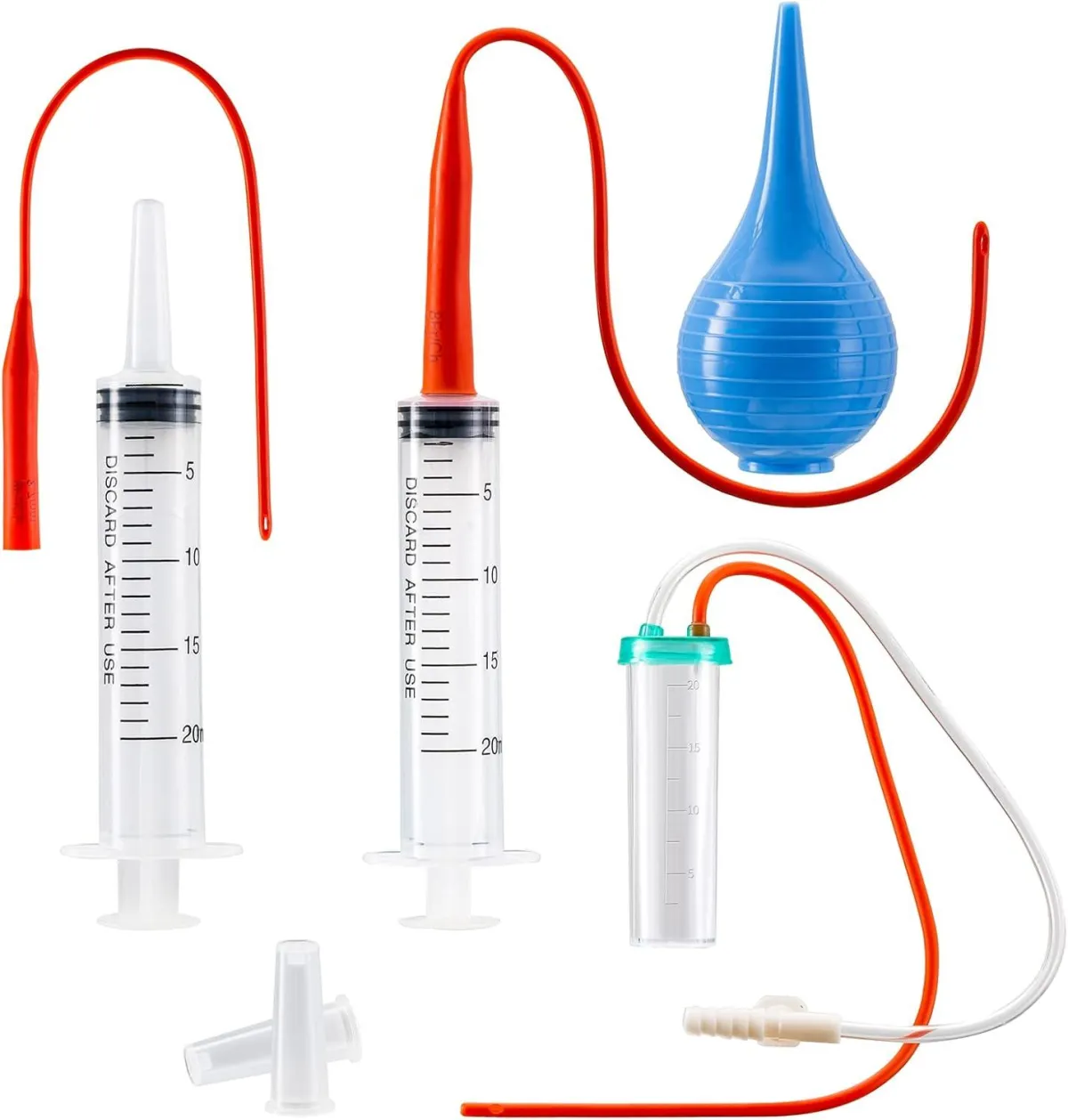
1-2 Heating pads or microwaveable heat disks
Warming box (plastic storage tub) with heat source under clean towels
Several clean, dry white towels of various sizes
Infant bulb syringe or DeLee mucus trap (pictured)
Pair of straight, blunt-tipped surgical scissors
Unwaxed dental floss or 2 hemostat forceps
2% Tincture of iodine in a shot glass
Small gauze pads (10-20)
Water soluble lubricant
2 or more 20cc syringes and compatible size 8 French feeding tubes (pictured)
1 or more 25g or smaller needle or acupuncture needle (for Jen Chung breathing
stimulation)
Puppy milk replacement (Esbilac) and bottles
Calcium supplement (Tums
Clock with second hand
Baby scale
Nitrile gloves
Several large potty pads or hospital pads
Garbage
Water bowl or bucket
Flashlight & leash for supervised bathroom breaks. Keep an eye out for puppies born outside
Resources For You
Comfy seat, this could take a while
Entertainment
Water and snacks
Gas in the car for emergency trips to vet
Snow removed from driveway
Assistant, either on call or in the house
Shave And A Hair Cut
If mom has long fur, it will help everyone stay much cleaner if you trim the fur on her back legs and around her nipples. Don’t shave or cut too short because you want some fur to protect mom from puppies’ nails.
Ask For Help
If mom has long fur, it will help everyone stay much cleaner if you trim the fur on her back legs and around her nipples. Don’t shave or cut too short because you want some fur to protect mom from puppies’ nails.
2. How to Predict When Whelping Will Occur
Ovulation And Mating
The average dog pregnancy lasts about 63 days (9 weeks). I’m not going to go very deeply into breeding strategies but if you’re dealing with a planned pregnancy and you know when your bitch ovulated you can predict whelping within a day or two. Ovulation can be predicted by changes in progesterone or luteinizing hormones.
Labor can also be predicted by measuring progesterone because a drop will occur 12-36 hours before labor begins. However, these methods require multiple trips to the vet for blood draws which equals more time, money and stress on your bitch. Knowing the date your bitch was bred will not give you an accurate whelping date because sperm can live for up to 11 days and eggs are viable for fertilization for 72 to 200 hours after ovulation so you will only get a very rough estimate this way.
Ultrasound
Ultrasound can be performed 24 days or more after ovulation to confirm pregnancy and fetal viability because heart beats and movement can be seen. If date of ovulation isn’t known, ultrasound can also reveal development of the organs and size of the skull which can give an idea of the due date.
X-Ray/Radiograph
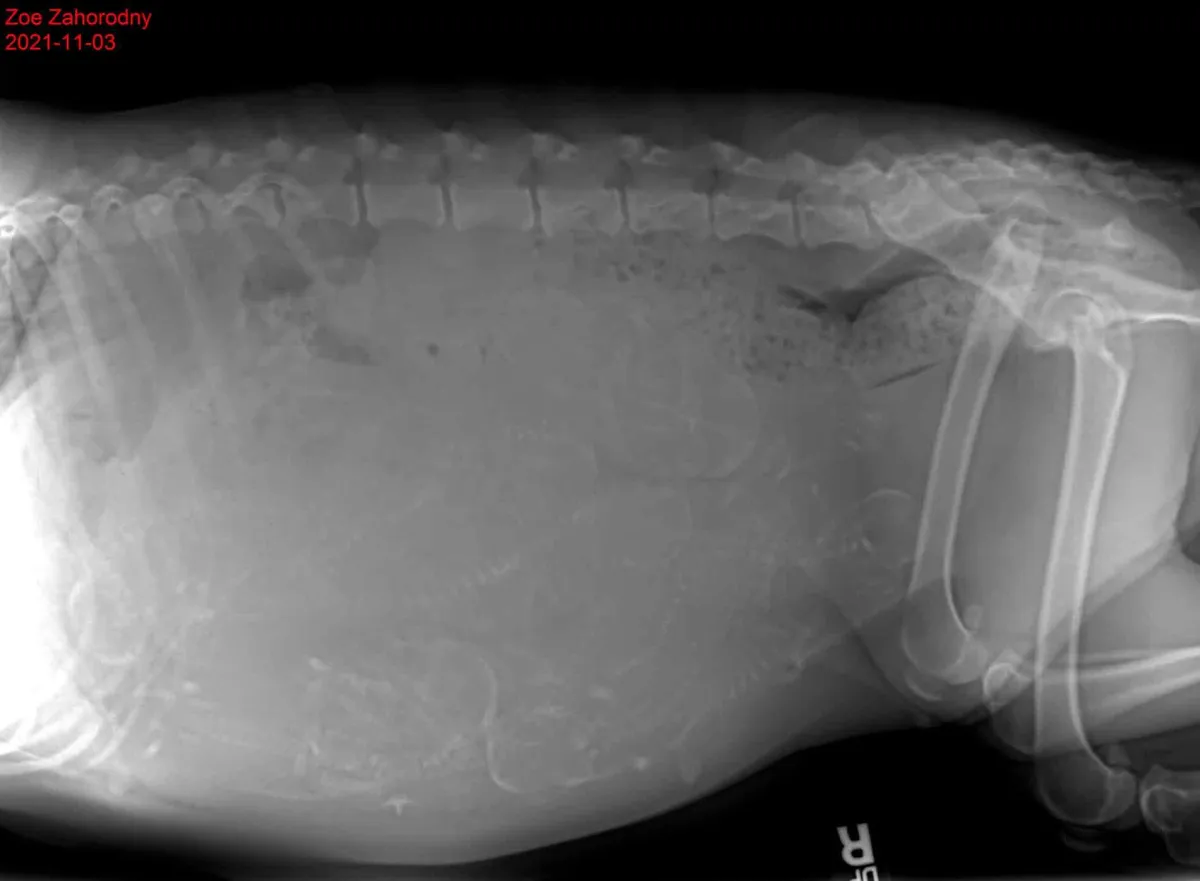
You could have x-rays taken but these are only helpful after the fetuses start to mineralize or develop their skeletal system which begins about 42-45 days after ovulation. About 4 days from whelping the paws, tail and teeth are visible. You may worry about exposure to radiation but there is minimal harm when done in late-stage pregnancy which is basically the only time x-rays are helpful. X-rays can also help determine litter size but sometimes puppies can obscure each other. Keep in mind that the trip to the vet may cause your dog stress.
Signs Of Labor
Decrease in appetite or vomiting
Restless and sedentary
Nesting and digging at bedding
Panting
Belly will sag
Mammary glands enlarge
Vulva becomes flaccid and pendulous
A sure sign is the presence of clear/straw colored or green/black/reddish brown vaginal discharge seen shortly before first puppy (can also be seen during birth and several days after birth.) Uteroverdin is a dark green component of the placenta and indicates that one has ruptured. If it has a strong odor or appears >30 min before first puppy, call your vet.
About 12-24 hours before birth, her body temperature will drop from a normal 101.5⁰F (38.6⁰C) to around 99⁰F (37.2⁰C) or 98⁰F (36.7⁰C) (see Free Downloads) for How To Take a Temp and Temp Log)
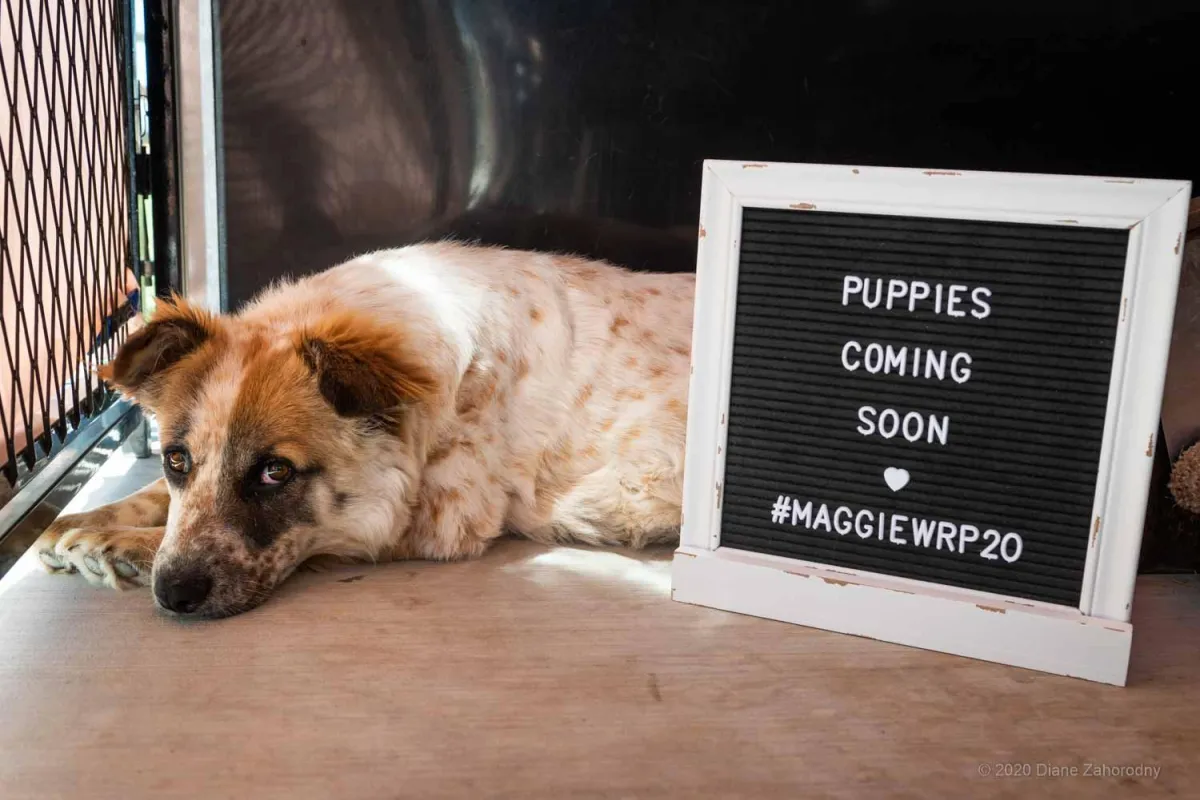
3. What To Expect During Whelping
Stage I Labor
Cervix dilates (not visible or palpable)
Uterine contractions begin (not visible or palpable)
Period of more intense nesting
Panting, pacing, whining, demanding attention, nervous, uncomfortable, licking genitals
Appearance of the mucus plug a clear, odorless, stringy vaginal discharge (like raw egg
white). This may appear before Stage I labor begins (pictured)
Clear, straw-colored or light pink fluid leaks from the birth canal
It is now safe to give your dog a calcium supplement (400mg of calcium per 10kg of body weight) This is to prevent eclampsia. DO NOT SUPPLEMENT CALCIUM DURING PREGNANCY
This is a good time to add heat to your warming box and warm up your towels either by placing them over a heat source or putting them in the dryer
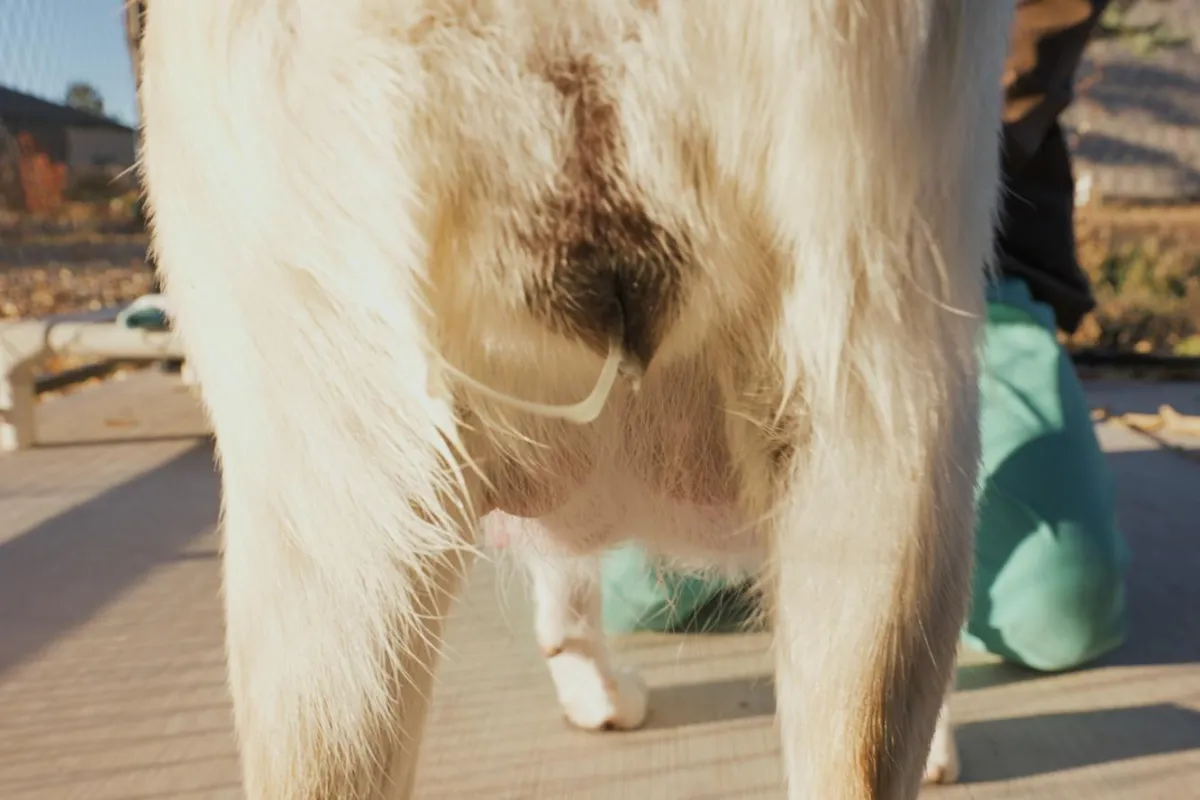
Stage II Labor
Productive labor begins, bitch begins to push
More clear, straw-colored or light pink fluid leaks from the birth canal
Uterine contractions intensify and abdominal muscular contractions are apparent
Puppies often appear as a bubble b/c they are encased in the amniotic sac. Mom will lick and tear at sac. Sometimes the sac will break before the puppy is born
The entire placenta usually follows each puppy and usually remains attached via the umbilical cord
She will continue to lick, clean and roll puppy, chew through umbilical cord and usually eat the placenta. She may vomit some later and her stools may be black and tar-like. This is all normal. There is some debate about allowing bitches to eat the placenta. It is natural but not necessary and does not affect lactation. Eating too many can cause digestive issues like diarrhea or vomiting which could pass on to the puppies. It's really up to you.
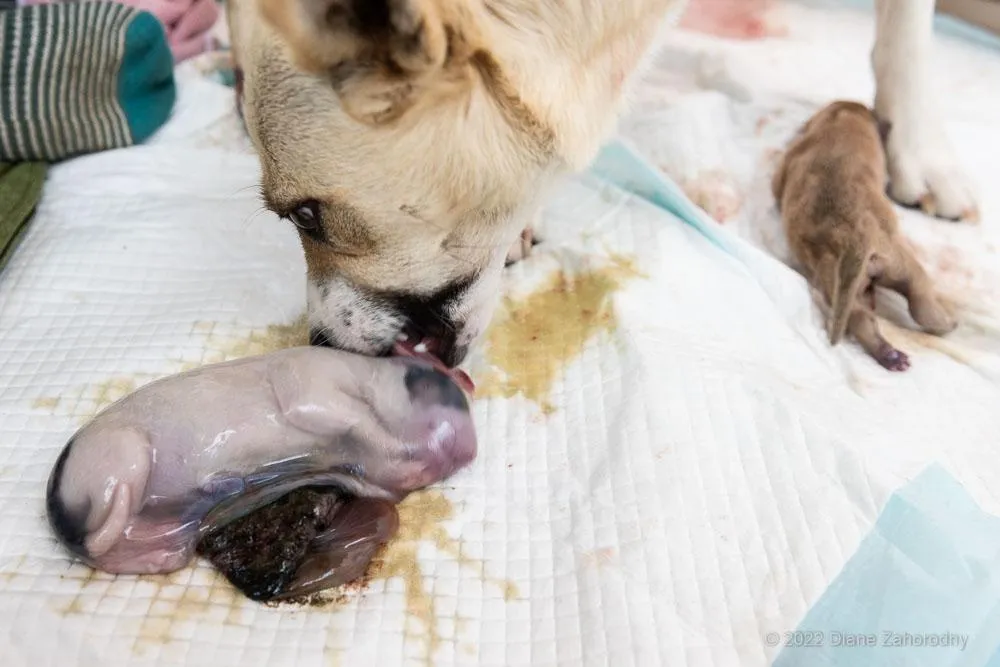
Typically, 5-180 minutes between puppies. Breaks, without pushing, are normal
Most deliveries take 4-6 hours total, but this can vary
Time between 1st and 2nd puppies is often longer than interval between later deliveries.
Sometimes delivered in pairs in quick succession (one from each uterine horn)
If you need to get puppies out of the way and it does not distress your dam, be sure they are dry, warm and breathing and place them in a warming box lined with a towel with a heating pad under it to keep them warm. Surface temp should be 95⁰F (35⁰C)
If Mom is willing to leave her puppies, she may need a bathroom break after a couple hours. KEEP HER ON A LEASH AND WATCH CLOSELY FOR PUPPIES BORN OUTSIDE. Bring a flashlight if it is dark
The whelping process is very dehydrating to occasionally offer her water but don’t leave the bowl in the whelping box where puppies could climb in and drown
If she is resting calmly with no contractions/pushing for 2 hours and no more puppies are expected she is probably done. If she is still having contractions but no puppy is produced within 15 min, call vet.
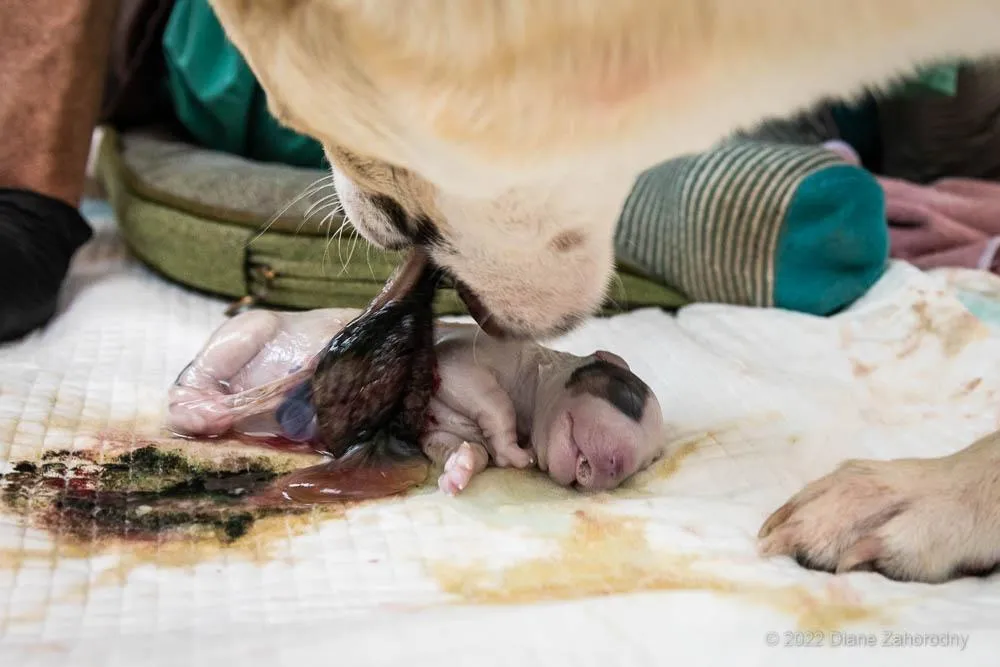
Normal Variations
Some bitches may show all, some or none of the signs above. There can be a lot of variation:
Mom may become reclusive
May not lose her appetite
May try to escape from the house and hide
May delay delivery until she is alone
Some puppies are born still inside the amniotic sac, and some are not
40% of puppies are born tail and hind feet first rather than head first. This can be a problem if the tail is visible but not the hind legs (breech birth, see EMERGENCY #4 in Worry Free Whelping Guide)
When To Call Your Vet
Once the placenta detaches from the uterine wall, the puppy is no longer receiving oxygen from its mother. There is still oxygen left in their blood stream but the clock is ticking. When and if labor does not proceed normally, this lack of oxygen is typically what you are working against in an emergency.
Stage I labor does not start within 24-36 hours of temperature drop
Stage I labor does not start within 12-36 hours of progesterone drop
>12-24 hours of Stage I labor with no pushing or puppies born
>30 min of pushing without birth of first puppy go to EMERGENCY #1 (Worry Free Whelping Guide)
>15 min of pushing without birth of subsequent puppies go to EMERGENCY #1 (Worry Free Whelping Guide)
>2 hours of resting (no pushing) between puppies and more are expected
Breech birth, only tail visible, no hind legs go to EMERGENCY #4 (Worry Free Whelping Guide)
Labor stops abruptly go to EMERGENCY #2 (Worry Free Whelping Guide)
Thick, foul smelling yellow or black fluid or excessive blood is seen before or during whelping (dark green fluids with no foul odor are normal)
Bitch behaving abnormally or showing signs of pain
Puppy is not breathing, noisy, warm or moving within minutes of being born go to EMERGENCY #3 (Worry Free Whelping Guide)

